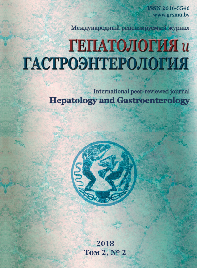PROGNOSTIC SIGNIFICANCE OF CD44 EXPRESSION IN COLON ADENOCARCINOMA
Abstract
Background. The risk of developing colorectal cancer is 5-6%, i.e., every 20th person develops cancer of this localization during a lifetime. A lot of works are devoted to the study of molecular markers for diagnosis and prognosis of tumors, especially at a young age. CD44 is one of these markers, but data on its role in predicting the course of colorectal cancer are contradictory.
Objective – determine the prognostic role of the CD44 positivity level in colon adenocarcinoma.
Material and methods. A clinical and morphological analysis of 61 cases of colon adenocarcinoma was investigated. Immunohistochemical study was performed using mouse monoclonal antibodies to CD44. Marker expression was quantified using the computer program Aperio Image Scope_v9.1.19.1567. Statistical analysis was performed using STATISTICA 10.0 (SNAXAR207F394425FA-Q).
Results. It was found that the level of CD44 in tumor tissue is significantly higher than at the margins of resection. At the same time, expression in the stroma of the tumor is significantly higher than in tumor proliferates. There were no statistically significant differences in the positivity of CD44 depending on sex, tumor location, degree of differentiation, depth of invasion and metastasis. The level of CD44 was determined to predict the survival of middle-aged patients.
Conclusion. If the level of parenchymal positivity of CD44 is equal to or below 0.284 with a sensitivity of 100% and a specificity of 80%, it can be predicted that the adjusted disease-free survival of middle-aged patients with colon adenocarcinoma will be more than 3 years.
References
1. Vojciechovska U, Didkovska J, Zatonski W. Pięcioletnie przeżycia u chorych na nowotwory złośliwe w Polsce [Fiveyear survival in patients with malignant tumors in Poland]. Nowotwory [Cancers]. 2010;60:122-128. (Polish).
2. Zatonski W, Didkovska J, Vojciechovska U. Epidemiologia chorob nowotworowych w Europie Środkoweji Wschodniej w porownaniu z Europą Zachodnią i Polską [Epidemiology of neoplastic diseases in Central and Eastern Europe in comparison with Western Europe and Poland]. Polski Przeglad Chrurgiczny [Polish Surgical Review]. 2009;8110:808-837. (Polish).
3. SEER Cancer Statistics Review, 1975-2013. Available from: https://seer.cancer.gov/csr/ 1975_2013/.
4. Kohnjuk VT. Rak obodochnoj kishki v Respublike Belarus: rasprostranennost, diagnostika i rezultaty lechenija [Colon cancer in the Republic of Belarus: prevalence, diagnosis and treatment outcomes]. Onkologicheskij zhurnal [Oncological journal]. 2013;27(3):21-26. (Russian).
5. O’Connell JB, Maggard MA, Liu JH, Etzioni DA, Livingston EH, Ko CY. Rates of colon and rectal cancers are increasing in young adults. American Surgeon. 2003;69(10):866-872.
6. O’Connell JB, Maggard MA, Livingston EH, Yo CK. Colorectal cancer in the young. American Journal of Surgery. 2004;187(3):343-348. doi: 10.1016/j.amjsurg.2003.12.020.
7. Fairley TL, Cardinez CJ, Martin J, Alley L, Friedman C, Edwards B, Jamison P. Colorectal cancer in U.S. adults younger than 50 years of age, 1998-2001. Cancer. 2006;107(5):1153-1161. doi: 10.1002/cncr.22012.
8. Nefedova NA. Malkov PG. Rol stvolovyh kletok v kancerogeneze tolstoj kishki [The role of stem cells in carcinogenesis of the colon]. Onkologicheskaja koloproktologija [Oncological coloproctology]. 2015;5:15-24. doi: 10.17650/2220-3478-2015-5-3-15-24. (Russian).
9. Yeung TM, Gandhi SC, Wilding JL, Muschel R, Bodmer WF. Cancer stem cells from colorectal cancer derived cell lines. PNAS. 2010;107(8):3722-3729. doi: 10.1073/pnas.0915135107.
10. Du L, Wang H, He L, Zhang J, Ni B, Wang X, Jin H, Cahuzac N, Mehrpour M, Lu Y, Chen Q. CD44 is of functional importance for colorectal cancer stem cells. Clinical Cancer Research. 2008;14(21):6751-6760. doi: 10.1158/1078-0432.CCR-08-1034.
11. Nagano O, Saya H. Mechanism and biological significance of CD44 cleavage. Cancer Science. 2004;95(12):930-935. doi: 10.1111/j.1349-7006.2004.tb03179.
12. Harada N, Mizoi T, Kinouchi M, Hoshi K, Ishii S, Shiiba K, Sasaki I, Matsuno S. Introduction of antisense CD44S CDNA down-regulates expression of overall CD44 isoforms and inhibits tumor growth and metastasis in highly metastatic colon carcinoma. International Journal of Cancer. 2001;91(1):67-75. doi: 10.1002/1097-0215(20010101)91.
13. Dallas MR, Liu G, Chen WC, Thomas SN, Wirtz D, Huso DL, Konstantopoulos K. Divergent roles of CD44 and carcinoembryonic antigen in colon cancer metastasis. The FASEB Journal. 2012;26(6):2648-2656. doi: 10.1096/fj.12-203786.
14. Shtabinskaya TT, Bodnar M, Lialikov SA, Basinskiy VA, Marshalek A. Prognosticheskoe znachenie urovnja jekspressii faktora rosta jendotelija sosudov v kolorektalnom rake [Assessment of prognostic significance of expression level of vascular endothelial growth factor in colorectal cancer]. Zhurnal Grodnenskogo gosudarstvennogo medicinskogo universiteta [Journal of the Grodno State Medical University]. 2015;51(3):64-69. (Russian).
15. Shtabinskaya TT, Bodnar M, Lialikov SA, Basinskiy VA, Marshalek A. Znachenie urovnja pozitivnosti CD105 v rake tolstoj kishki dlja prognoza jeffektivnosti himioterapii [The value of the CD105 positivity in colon cancer for the prognosis of the chemotherapy effectiveness]. Evrazijskij onkologicheskij zhurnal [Eurasian oncology journal]. 2015;4(07):35-42. (Russian).
16. Ropponen KM, Eskelinen MJ, Lipponen PK, Alhava E, Kosma VM. Expression of CD44 and variant proteins in human colorectal cancer and its relevance for prognosis. Scandinavian Journal of Gastroenterology. 1998;33(3):301-309. doi: 10.1080/00365529850170900.
17. Grabovoj AN, Savchin TM, Antonjuk SA, Tarasova TA. Jekspressija CD44 v adenokarcinomah tolstoj kishki [Expression of CD44 in colon adenocarcinomas]. Jeksperimentalnye issledovanija, onkomorfologija, onkoimmunologija [Experimental research, oncomorphology, oncoimmunology]. 2016;23(3):10-14. (Russian).
18. Huh JW, Kim HR, Kim YJ, Lee JH, Park YS, Cho SH, Joo JK. Expression of standard CD44 in human colorectal carcinoma: association with prognosis. Pathology International. 2009;59(4):241-247. doi: 10.1111/j.1440-1827.2009.02357.


















1.png)






